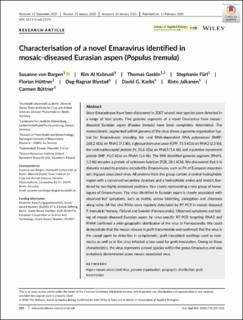| dc.contributor.author | Bargen, Susanne von | |
| dc.contributor.author | Kubrusli, Rim Al | |
| dc.contributor.author | Gaskin, Thomas | |
| dc.contributor.author | Fürl, Stephanie | |
| dc.contributor.author | Hüttner, Florian | |
| dc.contributor.author | Blystad, Dag-Ragnar | |
| dc.contributor.author | Karlin, David G. | |
| dc.contributor.author | Jalkanen, Risto | |
| dc.contributor.author | Büttner, Carmen | |
| dc.date.accessioned | 2020-04-15T10:23:19Z | |
| dc.date.available | 2020-04-15T10:23:19Z | |
| dc.date.created | 2020-04-07T19:25:43Z | |
| dc.date.issued | 2020-02-05 | |
| dc.identifier.citation | Annals of Applied Biology. 2020, 176 (2), 210-222. | en_US |
| dc.identifier.issn | 0003-4746 | |
| dc.identifier.uri | https://hdl.handle.net/11250/2651111 | |
| dc.description.abstract | Since Emaraviruses have been discovered in 2007 several new species were detected in a range of host plants. Five genome segments of a novel Emaravirus from mosaic‐diseased Eurasian aspen (Populus tremula) have been completely determined. The monocistronic, segmented ssRNA genome of the virus shows a genome organisation typical for Emaraviruses encoding the viral RNA‐dependent RNA polymerase (RdRP, 268.2 kDa) on RNA1 (7.1 kb), a glycoprotein precursor (GPP, 73.5 kDa) on RNA2 (2.3 kb), the viral nucleocapsid protein (N, 35.6 kDa) on RNA3 (1.6 kb), and a putative movement protein (MP, 41.0 kDa) on RNA4 (1.6 kb). The fifth identified genome segment (RNA5, 1.3 kb) encodes a protein of unknown function (P28, 28.1 kDa). We discovered that it is distantly related to proteins encoded by Emaraviruses, such as P4 of European mountain ash ringspot‐associated virus. All proteins from this group contain a central hydrophobic region with a conserved secondary structure and a hydrophobic amino acid stretch, bordered by two highly conserved positions, thus clearly representing a new group of homologues of Emaraviruses. The virus identified in Eurasian aspen is closely associated with observed leaf symptoms, such as mottle, yellow blotching, variegation and chloroses along veins. All five viral RNAs were regularly detectable by RT‐PCR in mosaic‐diseased P. tremula in Norway, Finland and Sweden (Fennoscandia). Observed symptoms and testing of mosaic‐diseased Eurasian aspen by virus‐specific RT‐PCR targeting RNA3 and RNA4 confirmed a wide geographic distribution of the virus in Fennoscandia. We could demonstrate that the mosaic‐disease is graft‐transmissible and confirmed that the virus is the causal agent by detection in symptomatic, graft‐inoculated seedlings used as rootstocks as well as in the virus‐infected scions used for graft‐inoculation. Owing to these characteristics, the virus represents a novel species within the genus Emaravirus and was tentatively denominated aspen mosaic‐associated virus. | en_US |
| dc.language.iso | eng | en_US |
| dc.rights | Navngivelse 4.0 Internasjonal | * |
| dc.rights.uri | http://creativecommons.org/licenses/by/4.0/deed.no | * |
| dc.subject | Aspen mosaic-associated virus | en_US |
| dc.subject | Genome organisation | en_US |
| dc.subject | Geographic distribution | en_US |
| dc.subject | Graft transmission | en_US |
| dc.title | Characterisation of a novel Emaravirus identified in mosaic-diseased Eurasian aspen (Populus tremula) | en_US |
| dc.type | Peer reviewed | en_US |
| dc.type | Journal article | en_US |
| dc.description.version | publishedVersion | en_US |
| dc.rights.holder | © 2020 The Authors. | en_US |
| dc.subject.nsi | VDP::Landbruks- og Fiskerifag: 900::Landbruksfag: 910::Planteforedling, hagebruk, plantevern, plantepatologi: 911 | en_US |
| dc.source.pagenumber | 210-222 | en_US |
| dc.source.volume | 176 | en_US |
| dc.source.journal | Annals of Applied Biology | en_US |
| dc.source.issue | 2 | en_US |
| dc.identifier.doi | 10.1111/aab.12576 | |
| dc.identifier.cristin | 1805598 | |
| dc.relation.project | COST (European Cooperation in Science and Technology): FA1407 | en_US |
| cristin.ispublished | true | |
| cristin.fulltext | original | |
| cristin.qualitycode | 1 | |

